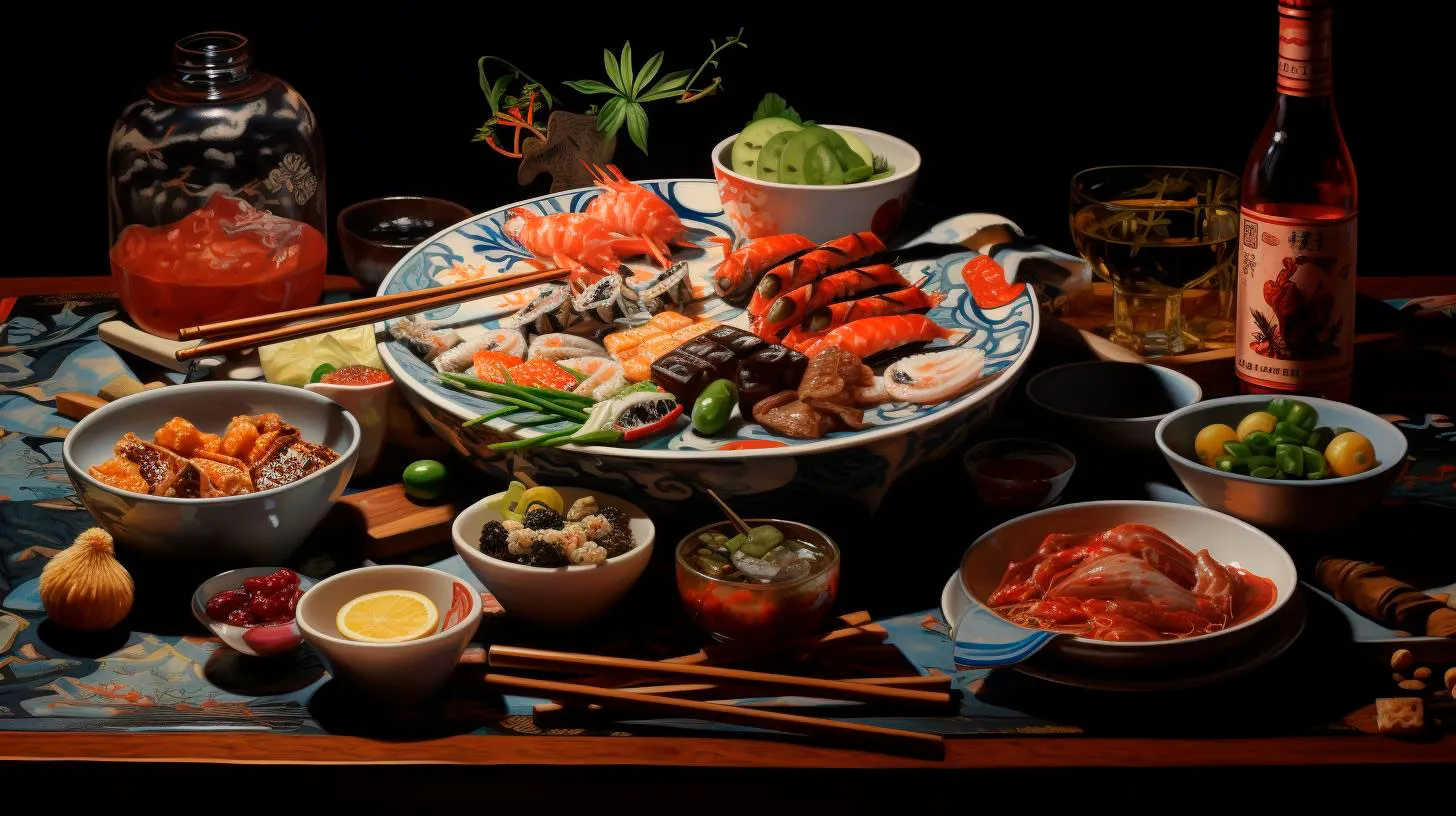Journey Through Time: Unveiling the Rich Tapestry of Sushi Historical Significance
But have you ever wondered about the historical significance of sushi and the fascinating journey it has taken to become the global sensation it is today? Join us as we embark on a captivating exploration of sushi’s rich tapestry, from its humble beginnings to its worldwide acclaim.
The Origins of Sushi: A Traditional Delicacy
Sushi, in its earliest form, dates back to the 2nd century AD in Southeast Asia. Its humble beginnings can be attributed to the preservation methods employed to store fish. Salted fish was packed in rice to ferment and preserve it for extended periods. This technique not only prevented the fish from spoiling but also created a unique flavor profile.
The 8th century witnessed the introduction of sushi to Japan. Influenced by Chinese culture, the Japanese refined the preservation method and began consuming the fermented rice along with the fish. However, it wasn’t until the Muromachi period in the 15th century that sushi transformed into the culinary delight we recognize today.
The Edo Period: The Birth of Modern Sushi
The Edo period, which lasted from the early 17th century to the mid-19th century, marked a pivotal moment in sushi’s history. It was during this time that street food stalls in Edo, now known as Tokyo, started serving nigiri sushi. Nigiri, meaning “hand-pressed,” involved placing a small mound of vinegared rice topped with a slice of fresh fish or other ingredients.
The advent of refrigeration techniques further revolutionized sushi-making by allowing fish to be stored for longer periods without compromising its freshness. This enabled sushi vendors to expand their offerings, giving rise to a rich variety of sushi styles and combinations.
Sushi’s Journey to Global Prominence
While sushi had been a prevalent local delicacy in Japan for centuries, it wasn’t until the mid-20th century that it gained international recognition. In the 1970s, Japanese restaurants began to emerge in major cities worldwide, introducing the art of sushi-making to a global audience.
Advancements in transportation and the growing popularity of Japanese cuisine played instrumental roles in sushi’s global prominence. The availability of fresh seafood in various parts of the world ensured that sushi lovers could enjoy authentic flavors regardless of their geographic location.
The Rise of Fusion Sushi
The fusion of different culinary traditions gave rise to a new wave of sushi experimentation. Sushi chefs around the world started incorporating local ingredients and flavors into traditional sushi, resulting in innovative and exciting combinations. This fusion approach to sushi-making sparked the creation of iconic dishes like California rolls and tempura sushi, further cementing sushi’s place in international cuisine.
The Contemporary Sushi Experience
Today, sushi is no longer solely confined to traditional sushi bars or high-end restaurants. Its popularity has spawned fast-food sushi chains, conveyor belt sushi establishments, and even DIY sushi kits available for home preparation.
Not only has sushi become more accessible, but it has also continued to evolve. Modern sushi chefs push the boundaries of creativity, using diverse ingredients and techniques to create culinary masterpieces that cater to a wide range of tastes.
Health Benefits and Key Takeaways
Aside from its exquisite taste, sushi offers numerous health benefits. Its primary ingredients, fish and rice, provide a rich source of omega-3 fatty acids, lean proteins, and carbohydrates. Some key takeaways about sushi include:
- Sushi is a nutrient-dense meal packed with essential vitamins and minerals.
- It offers a healthier alternative to many other fast-food options.
- The combination of fish and rice provides a balanced source of energy to fuel your day.
- It is a versatile dish that caters to various dietary preferences, with vegetarian and vegan options available.
In conclusion, sushi’s historical significance is an intricate tapestry that weaves cultural traditions, culinary craftsmanship, and global influences. From its humble origins as a preservation method to its status as a worldwide sensation, sushi continues to captivate our taste buds and spark our imagination. So, the next time you savor a piece of sushi, remember the remarkable journey it has taken to reach your plate.
Sushi: A Cultural Icon with Deep Roots in Japan Historical Narratives
In this article, we will delve into the rich history of sushi, exploring its origins, evolution, and the enduring legacy it carries today.
The Origins of Sushi
The history of sushi dates back over a thousand years. Its origins can be traced to the paddy fields of ancient Southeast Asia, where fish was fermented with rice as a way to preserve the catch for future consumption. This early form of sushi was known as narezushi, and it was often eaten as a staple food by fishermen and farmers.
As this technique spread to Japan around the 8th century, the process of fermenting fish with rice gradually evolved. The rice was no longer consumed and was only used as a means to enhance the flavor and texture of the fish. This revolutionary change gave birth to a new breed of sushi known as nigiri-zushi, which remains popular to this day.
The Evolution of Sushi
Over time, sushi continued to evolve and adapt to the changing culinary landscape of Japan. In the 19th century, a chef by the name of Hanaya Yohei revolutionized the sushi industry by introducing the concept of bite-sized pieces of sushi served on a plate. This innovation, known as Edomae sushi, further refined the art of sushi-making and paved the way for its commercialization.
Another significant development in sushi’s evolution occurred during the Edo period, where sushi became more accessible to the general public. Street vendors known as yatai would sell sushi rolls, known as makizushi, wrapped in seaweed. This convenient and portable form of sushi gained immense popularity, making it a favorite among commoners and samurai alike.
The Cultural Significance of Sushi
Today, sushi has transcended its humble origins to become an integral part of Japanese culture. It holds a special place in Japanese society and is deeply ingrained in their customs and traditions. Sushi is often served during celebrations, such as weddings and birthdays, as a symbol of good fortune, fertility, and longevity.
Furthermore, sushi has become a powerful ambassador for Japan on the global stage. The rise of Japanese cuisine in international markets has led to an increased demand for sushi, making it one of the most popular and recognizable dishes worldwide. Japanese sushi chefs, known as itamae, are highly regarded for their skill, precision, and artistry.
The Health Benefits of Sushi
In addition to its cultural significance, sushi also offers numerous health benefits that contribute to its popularity. Here are some key advantages:
- Rich in Omega-3 Fatty Acids: Sushi is typically made with fatty fish, such as salmon and tuna, which are excellent sources of omega-3 fatty acids. These healthy fats promote heart health, reduce inflammation, and support brain function.
- Low in Calories: Sushi rolls made with fresh ingredients and minimal added sauces are generally low in calories, making it a healthier alternative to many other fast food options.
- High in Protein: Sushi is a great source of lean protein, aiding in muscle growth, repair, and overall satiety.
- Rich in Antioxidants: Many sushi ingredients, such as seaweed, ginger, and wasabi, possess antioxidant properties that protect against cell damage and promote overall well-being.
Key Takeaways
Sushi, with its fascinating history and cultural significance, has undoubtedly secured its place as a global culinary icon. Here are some key takeaways to remember:
- Sushi has its roots in ancient Southeast Asia as a means of preserving fish.
- The evolution of sushi led to various forms, including nigiri-zushi and makizushi.
- Its accessibility and popularity during the Edo period propelled sushi into the mainstream.
- Sushi holds deep cultural significance in Japan, representing good fortune and celebration.
- Sushi’s health benefits, including omega-3 fatty acids and low calorie content, contribute to its popularity.
So the next time you savor a piece of sushi, take a moment to appreciate the centuries of history and culture that have shaped this beloved culinary masterpiece.
Tastes of Tradition: Exploring the Culinary Heritage of Japanese Cuisine
In this article, we will delve into the culinary heritage of Japanese cuisine, exploring its key features, advantages, and key takeaways.
A Taste of Tradition: Key Features
Japanese cuisine is known for its distinct features, which set it apart from other culinary traditions. Let’s take a closer look at some of these key features:
-
Umami, the Fifth Taste:
Umami, often described as the savory or meaty taste, is a fundamental aspect of Japanese cuisine. It is achieved by combining ingredients such as bonito flakes, shiitake mushrooms, and kelp, resulting in a depth of flavor that tantalizes the taste buds.
-
Artistic Presentation:
Japanese cuisine is not only a treat for the taste buds but also for the eyes. Traditional Japanese dishes are meticulously prepared and presented with great attention to detail. The exquisite arrangement of ingredients and the use of vibrant colors make every dish a work of art.
-
Seasonality and Freshness:
Japanese cuisine has a deep respect for seasonality and freshness. Ingredients are carefully selected based on what is in season to ensure optimal taste. This emphasis on fresh produce enhances the natural flavors and textures of the dishes.
-
Minimalism and Simplicity:
Japanese cuisine embraces the philosophy of simplicity, allowing the natural flavors of the ingredients to shine. The use of minimal seasoning and cooking techniques showcases the quality of the main components.
Advantages of Japanese Cuisine
There are numerous advantages to including Japanese cuisine in your culinary repertoire. Let’s explore some of them:
-
Health Benefits:
Japanese cuisine is renowned for its health benefits. With its emphasis on fresh ingredients, balanced portions, and minimal use of oils and fats, Japanese dishes provide a nutritious and well-balanced diet. Studies have shown that adhering to a Japanese-style diet can reduce the risk of various health conditions, including heart disease and certain types of cancer.
-
Diverse Flavors and Textures:
Japanese cuisine offers a wide range of flavors and textures, from delicate sashimi to hearty ramen bowls. With its extensive selection of ingredients and cooking techniques, Japanese cuisine provides a culinary experience that caters to various tastes and preferences.
-
Vegetarian and Vegan-Friendly Options:
Japanese cuisine offers a plethora of vegetarian and vegan-friendly dishes. From flavorful vegetable tempura to nourishing tofu-based dishes, the diverse range of options ensures that everyone can enjoy a satisfying meal.
-
Cultural Significance:
Exploring Japanese cuisine is not just a delightful culinary experience but also an opportunity to delve into the rich cultural heritage of Japan. Each dish carries with it stories, traditions, and a connection to the country’s history. By indulging in Japanese cuisine, we can gain a deeper understanding of the culture and traditions that have shaped this remarkable culinary tradition.
Key Takeaways
As we conclude our exploration of the culinary heritage of Japanese cuisine, here are some key takeaways to remember:
- Japanese cuisine is distinguished by its umami taste, artistic presentation, focus on seasonality and freshness, and embrace of minimalism.
- Including Japanese dishes in your diet can provide numerous health benefits and cater to diverse tastes and dietary preferences.
- Exploring Japanese cuisine allows us to appreciate the cultural significance and history behind each dish.
By preserving the traditions and flavors of Japanese cuisine, we uphold a culinary heritage rooted in centuries of craftsmanship and excellence. So take a moment to savor the tastes of tradition and embark on a tantalizing journey through the world of Japanese cuisine!
Historical Contexts: Tracing the Evolution of Sushi in Japanese Literature
In this article, we will explore the fascinating evolution of sushi in Japanese literature and its impact on the country’s culture and cuisine.
Early Depictions of Sushi in Japanese Literature
The origins of sushi can be found in Japan’s ancient past, and its mention in Japanese literature can be traced back as early as the 8th century. The first known written record of sushi appears in a book called “Shoku Nihongi,” which chronicles the history of Japan during the Nara period. This text describes sushi as a dish made with fermented fish wrapped in sour or vinegary rice.
During the Heian period (794-1185), sushi started to gain prominence in Japanese literature. In the seminal novel “The Tale of Genji” written by Lady Murasaki Shikibu, sushi is mentioned several times as a luxurious delicacy enjoyed by the aristocracy. The novel not only depicts the culinary aspects of sushi but also its cultural significance, as it was often associated with high social status and refinement.
- The mention of sushi in early Japanese literature highlights its long-standing culinary heritage.
- Sushi was seen as a delicacy enjoyed by the upper class, symbolizing wealth and sophistication.
Sushi’s Evolution in Edo Period Literature
The Edo period (1603-1868) marked a significant shift in sushi’s evolution, both in cuisine and literature. Sushi became more accessible to the general population, and its portrayal in literature reflected this change. During this period, a new type of sushi called nigiri sushi was invented, where a small ball of rice was topped with a slice of raw fish.
In the book “Shokoku-ji Monogatari” written by Ryutei Tanehiko, nigiri sushi makes an appearance as a favorite snack among the commoners in Edo (present-day Tokyo). This novel not only highlights the increasing popularity of sushi but also focuses on the bustling street vendors and sushi stalls that emerged in Edo.
- The Edo period saw the rise of nigiri sushi, a form that is still popular today.
- Sushi became more widely available and affordable, catering to the general public’s taste.
- The depiction of sushi stalls in Edo literature reflects the growing street food culture during that time.
Sushi’s Link to Modern Japanese Literature
As Japan transitioned into the modern era, sushi continued to play a significant role in Japanese culture and literature. In the early 20th century, works by renowned authors such as Natsume Soseki and Yasunari Kawabata depicted sushi as a staple food in the daily lives of ordinary people.
Natsume Soseki’s novel “Kusamakura” describes a scene where the protagonist enjoys a simple sushi meal at a traditional inn, emphasizing the beauty in simplicity and the connection between humans and nature. Yasunari Kawabata, a Nobel laureate, also incorporated sushi symbolism in his works. In “The Sound of the Mountain,” he uses sushi to convey themes of nostalgia, tradition, and the passing of time.
- Modern Japanese literature continued to portray sushi as a symbol of simplicity, tradition, and cultural identity.
- Sushi’s inclusion in literary works demonstrates its enduring significance in Japanese society.
Key Takeaways
Sushi’s evolution in Japanese literature mirrors its transformation from an elite delicacy to a beloved cultural icon. From the early depictions in “The Tale of Genji” to the portrayal in modern works by famous authors, sushi has captivated readers’ imaginations and taste buds throughout the centuries.
Understanding the historical contexts of sushi in Japanese literature allows us to appreciate its cultural significance and the timeless themes it represents. It is a reminder that sushi’s journey goes beyond the plate, intertwining culinary arts, social classes, and the shared experiences of people across generations.
So, the next time you savor a piece of sushi, take a moment to reflect on its historical roots and the profound impact it has had on Japanese literature and, consequently, on the nation’s entire cultural fabric.



